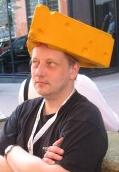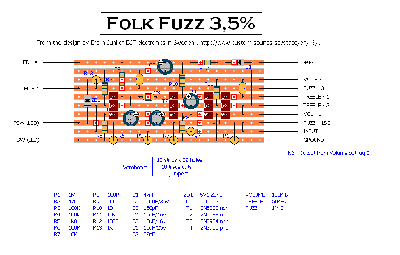Making your own PCBs
Moderator: Moderators
8 posts
• Page 1 of 1
Making your own PCBs
A thread for instruction on making a PCB in general or the Folk Fuzz in particular
-

Donner - Site Admin
- Posts: 3547
- Joined: Mon Feb 26, 2007 11:52 pm
- Location: St.Louis
- Guitars:: Strats, Teles, LPSpecial, Silvertone, #1 is a Gretschified Flying V
- amps: custom plexitweed KT66>2x12 Greenbacks, Deluxe and Princeton Reverbs
- pedals: 0
Re: Making your own PCBs
I was able to upload the schem, and 1 layer PCB layout below.....
http://freestompboxes.org/viewtopic.php?f=13&t=2979
http://freestompboxes.org/viewtopic.php?f=13&t=2979
Part time pedal builder with a day job now with a web site http://www.fromelelectronics.com
- jfromel
- Posts: 201
- Joined: Sun Aug 10, 2008 3:02 pm
Re: Making your own PCBs
Is there interest in doing this - you are welcome to connect with others doing or trying this out here..... could do a sort of sign up for those interested in this
-

Donner - Site Admin
- Posts: 3547
- Joined: Mon Feb 26, 2007 11:52 pm
- Location: St.Louis
- Guitars:: Strats, Teles, LPSpecial, Silvertone, #1 is a Gretschified Flying V
- amps: custom plexitweed KT66>2x12 Greenbacks, Deluxe and Princeton Reverbs
- pedals: 0
Re: Making your own PCBs
Someone posted a perfboard layout as well at the link above, very cool.
Part time pedal builder with a day job now with a web site http://www.fromelelectronics.com
- jfromel
- Posts: 201
- Joined: Sun Aug 10, 2008 3:02 pm
Re: Making your own PCBs
maybe someone would be willing to do that here 
-

Donner - Site Admin
- Posts: 3547
- Joined: Mon Feb 26, 2007 11:52 pm
- Location: St.Louis
- Guitars:: Strats, Teles, LPSpecial, Silvertone, #1 is a Gretschified Flying V
- amps: custom plexitweed KT66>2x12 Greenbacks, Deluxe and Princeton Reverbs
- pedals: 0
Re: Making your own PCBs
Part time pedal builder with a day job now with a web site http://www.fromelelectronics.com
- jfromel
- Posts: 201
- Joined: Sun Aug 10, 2008 3:02 pm
Re: Making your own PCBs
ah cool I meant sort of a tutorial when t he time comes, it would be educational for people to see how they are made....tho i dont know if many here would try it the first time anyway 
-

Donner - Site Admin
- Posts: 3547
- Joined: Mon Feb 26, 2007 11:52 pm
- Location: St.Louis
- Guitars:: Strats, Teles, LPSpecial, Silvertone, #1 is a Gretschified Flying V
- amps: custom plexitweed KT66>2x12 Greenbacks, Deluxe and Princeton Reverbs
- pedals: 0
Re: Making your own PCBs The low tech approach
Hi,
It's also possible to use Vectorboard and then you can place the components more or less as they read from the schematic and use the componentlegs for interconnections.
Vectorboard is a predrilled piece like vero board but vectorboard has no copperlines.
There are also glasfibre experimental boards that have solder islands around each hole and each hole is spaced just like on vector/vero board howver this is tricky to use and requires a certain skill level.
Making your own pcb from plain laminat is also easy.
The easiest way is to first draw the components on a piece of paper in the fashion you'd like them to sit on the pcb and you'd do this in scale 1:1.You can use red pen for the lines and black for components on the component side.
This may take a little bit of practicing and it's a good thing if the pens used are ereasable just in case- but anyway the layout can be drawn more or less as the schematic reads from left to right
You then cut a sufficient piece of laminat and place and place the paper so that the drawing fits within the realms of the laminat piece and then secure the paper with tape and make sure the laminat side is facing the paper underside.
You can now drill through the paper each hole needed and when all holes are drilled, loosen the paper and tape the paper to a lamp so with the lamp shining onto the drawn part but through the paper so you can see the mirror reflection.
Now filp the laminate and scrape off all protruding copper parts and use an ereaser gum to remove possible grease aand now you can draw the red lines onto the laminat.You will need a pen that has ink that will resist the heat and the etchant- suitable pens can be had from your electronic supplier
Once the pattern is drawn it's time to etch and that is done by mixing etching powder with boiling water in a plastic tray and then you just slip the laminate into the tray and let it etch.
To speed up etching a plastic propeller can be used- make sure this propeller has no metallic parts-suitable propellers can be found on toy submarines btw
When etching is done the pattern will remain in black and the inc can be removed with acetone or sanded down with fine metal sandpaper.
Once no ink is left and all lines are inspected to be correct and of good quality the componentboard is ready to be stuffed with parts.
Have fun
BJ
It's also possible to use Vectorboard and then you can place the components more or less as they read from the schematic and use the componentlegs for interconnections.
Vectorboard is a predrilled piece like vero board but vectorboard has no copperlines.
There are also glasfibre experimental boards that have solder islands around each hole and each hole is spaced just like on vector/vero board howver this is tricky to use and requires a certain skill level.
Making your own pcb from plain laminat is also easy.
The easiest way is to first draw the components on a piece of paper in the fashion you'd like them to sit on the pcb and you'd do this in scale 1:1.You can use red pen for the lines and black for components on the component side.
This may take a little bit of practicing and it's a good thing if the pens used are ereasable just in case- but anyway the layout can be drawn more or less as the schematic reads from left to right
You then cut a sufficient piece of laminat and place and place the paper so that the drawing fits within the realms of the laminat piece and then secure the paper with tape and make sure the laminat side is facing the paper underside.
You can now drill through the paper each hole needed and when all holes are drilled, loosen the paper and tape the paper to a lamp so with the lamp shining onto the drawn part but through the paper so you can see the mirror reflection.
Now filp the laminate and scrape off all protruding copper parts and use an ereaser gum to remove possible grease aand now you can draw the red lines onto the laminat.You will need a pen that has ink that will resist the heat and the etchant- suitable pens can be had from your electronic supplier
Once the pattern is drawn it's time to etch and that is done by mixing etching powder with boiling water in a plastic tray and then you just slip the laminate into the tray and let it etch.
To speed up etching a plastic propeller can be used- make sure this propeller has no metallic parts-suitable propellers can be found on toy submarines btw
When etching is done the pattern will remain in black and the inc can be removed with acetone or sanded down with fine metal sandpaper.
Once no ink is left and all lines are inspected to be correct and of good quality the componentboard is ready to be stuffed with parts.
Have fun
BJ
-

BJF - Posts: 522
- Joined: Tue Feb 27, 2007 4:43 am
- Location: Stockholm
- Guitars:: Les Pauls, V with P-90's and humbuckers, strats,tele duo-jet and expanding; pick ups mostly Lundgren or BJF/ Lundgren
Danelectro Barython - amps: MP CS-40, MP101, Hiwatt Custom 200, Hiwatt Custom 100, VOX AC15
Fender Blues De Ville, Fender Super Reverb, Marshall 5150 through various speakers - pedals: 42
8 posts
• Page 1 of 1
Return to Folk Forum (DIY projects)
Who is online
Users browsing this forum: No registered users and 2 guests

